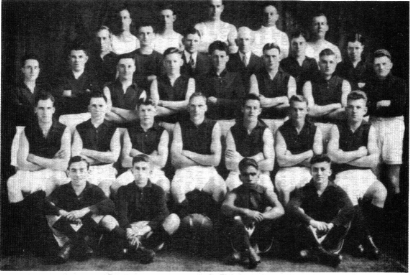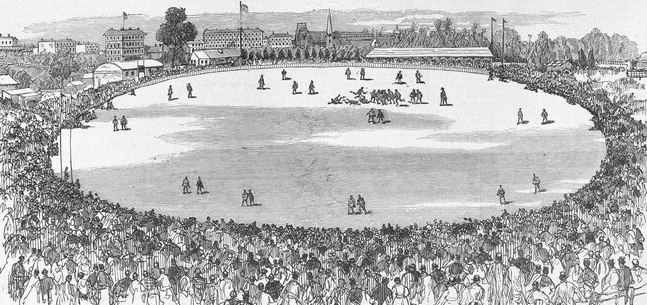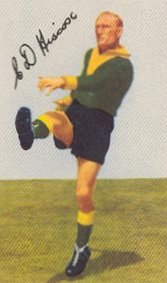|
Douglas Nicholls
Sir Douglas Ralph Nicholls, (9 December 1906 – 4 June 1988) was a prominent Aboriginal Australian from the Yorta Yorta people. He was a professional athlete, Churches of Christ pastor and church planter, ceremonial officer and a pioneering campaigner for reconciliation. Nicholls was the first Aboriginal Australian to be knighted when he was appointed Knight Bachelor in 1972 (he was subsequently appointed a Knight Commander of the Royal Victorian Order in 1977). He was also the first — and to date the only — Indigenous Australian to be appointed to vice-regal office, serving as Governor of South Australia from 1 December 1976 until his resignation on 30 April 1977 due to poor health. Early life Nicholls was born on 9 December 1906 on the Cummeragunja Reserve in New South Wales.Richard Broome, Sir Douglas Ralph (Doug) (1906–1988)', Australian Dictionary of Biography, National Centre of Biography, Australian National University, , published first in hardcopy 2012, acc ... [...More Info...] [...Related Items...] OR: [Wikipedia] [Google] [Baidu] |
Pastor
A pastor (abbreviated as "Pr" or "Ptr" , or "Ps" ) is the leader of a Christian congregation who also gives advice and counsel to people from the community or congregation. In Lutheranism, Catholicism, Eastern Orthodoxy, Oriental Orthodoxy and Anglicanism, pastors are always ordained. In Methodism, pastors may be either licensed or ordained. Pastors are to act like shepherds by caring for the flock, and this care includes teaching. The New Testament typically uses the words "bishops" ( Acts 20:28) and "presbyter" ( 1 Peter 5:1) to indicate the ordained leadership in early Christianity. Likewise, Peter instructs these particular servants to "act like shepherds" as they "oversee" the flock of God ( 1 Peter 5:2). The words "bishop" and "presbyter" were sometimes used in an interchangeable way, such as in Titus 1:5-6. However, there is ongoing dispute between branches of Christianity over whether there are two ordained classes (presbyters and deacons) or three (bishops, priests ... [...More Info...] [...Related Items...] OR: [Wikipedia] [Google] [Baidu] |
Governor Of South Australia
The governor of South Australia is the representative in South Australia of the Monarch of Australia, currently King Charles III. The governor performs the same constitutional and ceremonial functions at the state level as does the governor-general of Australia at the national level. In accordance with the conventions of the Westminster system of parliamentary government, the governor nearly always acts solely on the advice of the head of the elected government, the Premier of South Australia. Nevertheless, the governor retains the reserve powers of the Crown, and has the right to dismiss the Premier. As from June 2014, the Queen, upon the recommendation of the Premier, accorded all current, future and living former governors the title 'The Honourable' for life. The first six governors oversaw the colony from proclamation in 1836, until self-government and an elected Parliament of South Australia was granted in the year prior to the inaugural 1857 election. The first Austral ... [...More Info...] [...Related Items...] OR: [Wikipedia] [Google] [Baidu] |
Australian Football League
The Australian Football League (AFL) is the only fully professional sports, professional competition of Australian rules football. Through the AFL Commission, the AFL also serves as the sport's governing body and is responsible for controlling the Laws of Australian football, laws of the game. Originally known as the Victorian Football League (VFL), it was founded in 1896 as a breakaway competition from the Victorian Football Association (VFA), with 1897 VFL season, its inaugural season commencing the following year. The VFL, aiming to become a national competition, began expanding beyond Victoria (Australia), Victoria to other Australian states in the 1980s, and changed its name to the AFL in 1990. The league currently consists of 18 teams spread over five of Australia's six states (Tasmania being the exception). Matches have been played in all states, plus the Australian Capital Territory and the Northern Territory, as well as in New Zealand and China to expand the league's au ... [...More Info...] [...Related Items...] OR: [Wikipedia] [Google] [Baidu] |
Australian Rules Football
Australian football, also called Australian rules football or Aussie rules, or more simply football or footy, is a contact sport played between two teams of 18 players on an oval field, often a modified cricket ground. Points are scored by kicking the oval ball between the central goal posts (worth six points), or between a central and outer post (worth one point, otherwise known as a "behind"). During general play, players may position themselves anywhere on the field and use any part of their bodies to move the ball. The primary methods are kicking, handballing and running with the ball. There are rules on how the ball can be handled; for example, players running with the ball must intermittently bounce or touch it on the ground. Throwing the ball is not allowed, and players must not get caught holding the ball. A distinctive feature of the game is the mark, where players anywhere on the field who catch the ball from a kick (with specific conditions) are awarded unim ... [...More Info...] [...Related Items...] OR: [Wikipedia] [Google] [Baidu] |
1929 VFA Season
The 1929 Victorian Football Association season was the 51st season of the Australian rules football competition. The premiership was won by the Northcote Football Club, after it defeated Port Melbourne by 42 points in the Grand Final on 12 October. It was the club's first VFA premiership. Association membership In November 1928, the Oakleigh Football Club applied to join the Association. Oakleigh had been a successful club in the Sub-District Association, had a good quality ground, the growing suburb of Oakleigh provided the team strong support, and the club had been previously considered for Association membership. Oakleigh's application was accepted unanimously. In February 1929, the Sandringham council applied to the Association to establish a local senior team in the competition. The Association approved the application, subject to the council receiving permission from the Minister for Lands to erect a fence around its home ground, Beach Park, which it received on 22 Fe ... [...More Info...] [...Related Items...] OR: [Wikipedia] [Google] [Baidu] |
Victoria Australian Rules Football Team
The Victoria Australian rules football team, known colloquially as the Big V, is the state representative side of Victoria, Australia, in the sport of Australian rules football. The Big V has a proud history, dominating the first 100 years of intercolonial-interstate football, and being the most successful state in State of Origin. After the change to State of Origin rules, the results with the other main Australian football states became more even. Victoria has a long and intense rivalry with South Australia and Western Australia. The Victorian and South Australian rivalry was characterised by the catchcry in South Australia called "Kick a Vic", and fans would bring signs of the cry to the games. Some of the games between Victoria, South Australia and Western Australia in the 1980s and 1990s have been regarded as some of the greatest games in the history of Australian football. Victoria's last appearance against another state at open level was in 1999 when it defeated South ... [...More Info...] [...Related Items...] OR: [Wikipedia] [Google] [Baidu] |
Fitzroy Football Club
The Fitzroy Football Club is an Australian rules football club currently competing in the Victorian Amateur Football Association (VAFA). Formed in 1883 to represent the inner-Melbourne municipality of Fitzroy, the club was a member of the Victorian Football Association (VFA), before becoming a foundation member of the breakaway Victorian Football League (VFL/AFL) in 1897. Fitzroy won a total of eight VFL premierships, of which seven (1898, 1899, 1904, 1905, 1913, 1916 and 1922) were won whilst they were nicknamed the Maroons and one (1944) as the Gorillas. The decision of the club to change its nickname to the Lions in 1957 coincided with what history now records as the beginning of decades of poor on-field performance and financial losses that eventually resulted in the club being placed into administration, ultimately leaving the AFL at the end of the 1996 season. That year the club's AFL playing operations merged with the Brisbane Bears to form the Brisbane Lions. It e ... [...More Info...] [...Related Items...] OR: [Wikipedia] [Google] [Baidu] |
Northcote Football Club
Northcote Football Club (/ˈnoːθ.kət/), nicknamed The Dragons, was an Australian rules football club which played in the VFA from 1908 until 1987. The club's colours for most of its time in the VFA were green and yellow and it was based in the Melbourne suburb of Northcote. History The earliest mentions of a Northcote Football Club club appear in mid 1869. The club was established as a junior club, and it initially contested the Victorian Junior Football Association. The club played its games at Croxton Park until 1903, before moving to Northcote Park in 1904. The club was successful at junior level during the 1900s, winning premierships in 1904 and 1906. The club then joined senior football in the Victorian Football Association from the VJFA in 1908, and moved its home ground back to Croxton Park in 1909. Prior to the 1912 season, Northcote and neighbouring northern suburban club Preston, who were both struggling on-field, amalgamated; the merged club was known as the ... [...More Info...] [...Related Items...] OR: [Wikipedia] [Google] [Baidu] |
Tongala Football Club
The Tongala Football Club, nicknamed the Blues, is an Australian rules football club playing in the Murray Football League. The club is based in the town of Tongala located in the north of Victoria. History The Tongala Football Club was formed in 1894 in a meeting at Mangan's Victoria Hotel, Tongala, with games played at Tongala Recreation Reserve. Tongala initially wore a red jumper with black horizontal bars in 1894. In 1919, Tongala's application for admission into the Goulburn Valley Football League was rejected on the grounds that Tongala was not a strong enough team. The club has participated in a number of local football leagues over the years with great success. Football competitions timeline Tongala FC have competed in the following football competitions – *1910 to 1914: Kyabram District Junior Football Association *1915 to 1918: Club in recess, due to World War I *1919 to 1923: Kyabram District Junior Football Association *1924 to 1932: Goulburn Valley Foo ... [...More Info...] [...Related Items...] OR: [Wikipedia] [Google] [Baidu] |
Northcote 1929
Northcote may refer to: People with the surname * Sir Geoffry Northcote (1881–1948), British colonial administrator * Hannah Northcote (c.1761–1831), English silversmith * Henry Northcote (other) * James Northcote (1746–1831), British painter * James Spencer Northcote (1821–1907), English priest and writer * Percy Northcote (1866–1934), English cricketer * Stafford Northcote, 1st Earl of Iddesleigh (1818–1887), British politician * Stafford Harry Northcote, Viscount Saint Cyres (1869–1926), diplomat and historian * Walter Northcote, 2nd Earl of Iddesleigh (1845–1927) Places * Northcote, Devon, a location in England * Northcote, Langho, a hotel and restaurant in Lancashire, England * Northcote, Auckland, a suburb of Auckland, New Zealand **Northcote Central **Northcote Tigers, a rugby league club * Northcote, Christchurch, a suburb of Christchurch, New Zealand * Northcote, Victoria, a suburb of Melbourne, Australia **Northcote City FC **Northcote Foo ... [...More Info...] [...Related Items...] OR: [Wikipedia] [Google] [Baidu] |
Australian Dollar
The Australian dollar (sign: $; code: AUD) is the currency of Australia, including its external territories: Christmas Island, Cocos (Keeling) Islands, and Norfolk Island. It is officially used as currency by three independent Pacific Island states: Kiribati, Nauru, and Tuvalu. It is legal tender in Australia.''Reserve Bank Act 1959'', s.36(1) an ''Currency Act 1965'', s.16 Within Australia, it is almost always abbreviated with the dollar sign ($), with A$ or AU$ sometimes used to distinguish it from other [...More Info...] [...Related Items...] OR: [Wikipedia] [Google] [Baidu] |
Australian Pound
The pound ( Sign: £, £A for distinction) was the currency of Australia from 1910 until 14 February 1966, when it was replaced by the Australian dollar. As with other £sd currencies, it was subdivided into 20 shillings (denoted by the symbol s or /–), each of 12 pence (denoted by the symbol d). History The establishment of a separate Australian currency was contemplated by section 51(xii) of the Constitution of Australia, which gave Federal Parliament the right to legislate with respect to "currency, coinage, and legal tender". Establishment Coinage The Deakin Government's ''Coinage Act 1909'' distinguished between "British coin" and "Australian coin", giving both status as legal tender of equal value. The Act gave the Treasurer the power to issue silver, bronze and nickel coins, with the dimensions, size, denominations, weight and fineness to be determined by proclamation of the Governor-General. The first coins were issued in 1910, produced by the Royal Mint ... [...More Info...] [...Related Items...] OR: [Wikipedia] [Google] [Baidu] |

.jpg)





